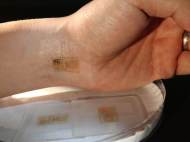Skin electronics that stick and stretch like temporary tattoo stickers
 A multi-disciplinary team of researchers, led by researchers from the University of Illinois, came up with epidermal electronic system (EES) – a device platform based on a thin skin-like patch that mounts directly onto the skin with ease and flexibility of a temporary tattoo sticker. The technology could be used in electronic components for sensing, medical diagnostics, communications and human-machine interfaces.
A multi-disciplinary team of researchers, led by researchers from the University of Illinois, came up with epidermal electronic system (EES) – a device platform based on a thin skin-like patch that mounts directly onto the skin with ease and flexibility of a temporary tattoo sticker. The technology could be used in electronic components for sensing, medical diagnostics, communications and human-machine interfaces.
“We threw everything in our bag of tricks onto that platform, and then added a few other new ideas on top of those, to show that we could make it work”, said research leader John A. Rogers, the Lee J. Flory-Founder professor of engineering at the University of Illinois.
The circuit bends, wrinkles and stretches with the mechanical properties of skin. The patches are initially mounted on a thin sheet of water-soluble plastic which can be applied to the skin with water in a way you apply a temporary tattoo sticker. Another way is to apply the electronic components directly to a temporary tattoo itself, thus providing concealment for the electronics.
Rogers collaborated with Northwestern University engineering professor Yonggang Huang and his group in order to develop a device geometry dubbed filamentary serpentine. When mounted on thin, soft rubber sheets, the wavy, snakelike shape allows them to bend, twist, scrunch and stretch while maintaining functionality.
The researchers demonstrated their concept through a diverse array of electronic components mounted on a thin, rubbery substrate, including sensors, LEDs, transistors, radio frequency capacitors, wireless antennas, and conductive coils and solar cells for power. Their next goal is to add the Wi-Fi capability and to integrate various individually functioning devices mounted on the platform so that they could operate as a system.
“The vision is to exploit these concepts in systems that have self-contained, integrated functionality, perhaps ultimately working in a therapeutic fashion with closed feedback control based on integrated sensors, in a coordinated manner with the body itself”, said Rogers.
Skin-like circuits don’t require conductive gel, tape, skin-penetrating pins or bulky wires which limit coupling efficiency, making them more comfortable to wear and enabling complete freedom of movement of the wearer.
Since it is almost unnoticeable to the wearer, the skin-mounted electronics have many biomedical applications. Aside EEG and EMG sensors used to monitor nerve and muscle activity, skin-mounted electronics could be used to aid patients with muscular or neurological disorders or as a human-computer interface. The researchers found that, when applied to the skin of the throat, the sensors could distinguish muscle movement for simple speech.
The researchers used simple adaptations of techniques used in the semiconductor industry, so the patches are easily scalable and produced. The device company mc10, which Rogers co-founded, is already working to commercialize certain versions of the technology.
For more information, read the article published in the journal Science named: “Epidermal Electronics”.









I thank you